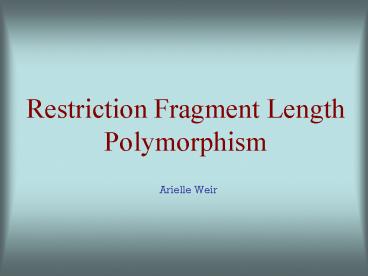Restriction Fragment Length Polymorphism - PowerPoint PPT Presentation
1 / 7
Title:
Restriction Fragment Length Polymorphism
Description:
Restriction Fragment Length Polymorphism Arielle Weir The Uses Polymorphism, which is in both coding and noncoding parts, is a difference in DNA that can be analyzed ... – PowerPoint PPT presentation
Number of Views:265
Avg rating:3.0/5.0
Title: Restriction Fragment Length Polymorphism
1
Restriction Fragment Length Polymorphism
- Arielle Weir
2
The Uses
- Polymorphism, which is in both coding and
noncoding parts, is a difference in DNA that can
be analyzed between two different origins. - Two individuals of the same species have the same
genome, but different alleles. - RFLP is the comparison of different patterns
produced by individual lengths of fragments. - It can be used to compare samples from a crime in
forensic sciences against a suspect. - It can be used to compare a patient's DNA against
a standard pattern to see if a genetic mutation
has occurred, such as sickle cell anemia.
3
Method
The sample of DNA is first cut up using
restriction endonucleases. The sample must be
quite large, to have enough to compare. This can
be blood the size of a quarter, semen the size of
a dime, etc. This creates many fragments of the
DNA.
4
The fragments are pulled through gel using gel
electrophoresis. Since there are so many
fragments, they cannot be clearly identified.
They appear as long smears. The whole gel is
placed in a chemical that separates the DNA into
single strands.
5
The DNA fragments are moved from the gel to a
nylon membrane. This is achieved through a
process called Southern blotting. Since DNA is
negatively charged, when a positive electrode is
put behind the nylon, the DNA moves towards it
and binds.
6
Once the DNA has bound to the nylon membrane, the
whole thing is dipped into a solution with
radioactive complimentary nucleotide probes for
parts that have been chosen to be compared, such
as certain alleles that may have a mutation or
parts that will not be the same in another
person. These probes will bind to the
complimentary sequence of DNA with hydrogen
bonds. This is called hybridization.
7
An X ray film is then put on top of the nylon for
two to three weeks. The radioactive probes make
the film expose, creating patterns in the film.
This is called an autoradiogram. The patterns
that are created are unique to every individual.
These can now be compared to find matches.































